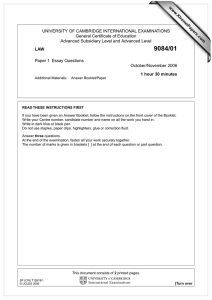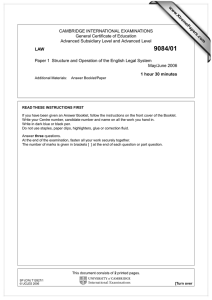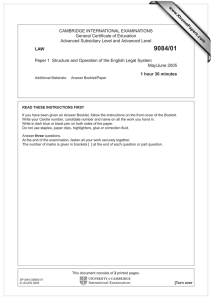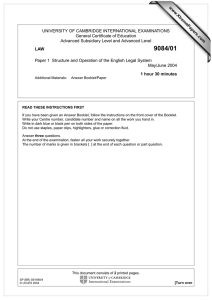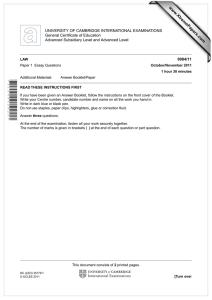www.XtremePapers.com
advertisement
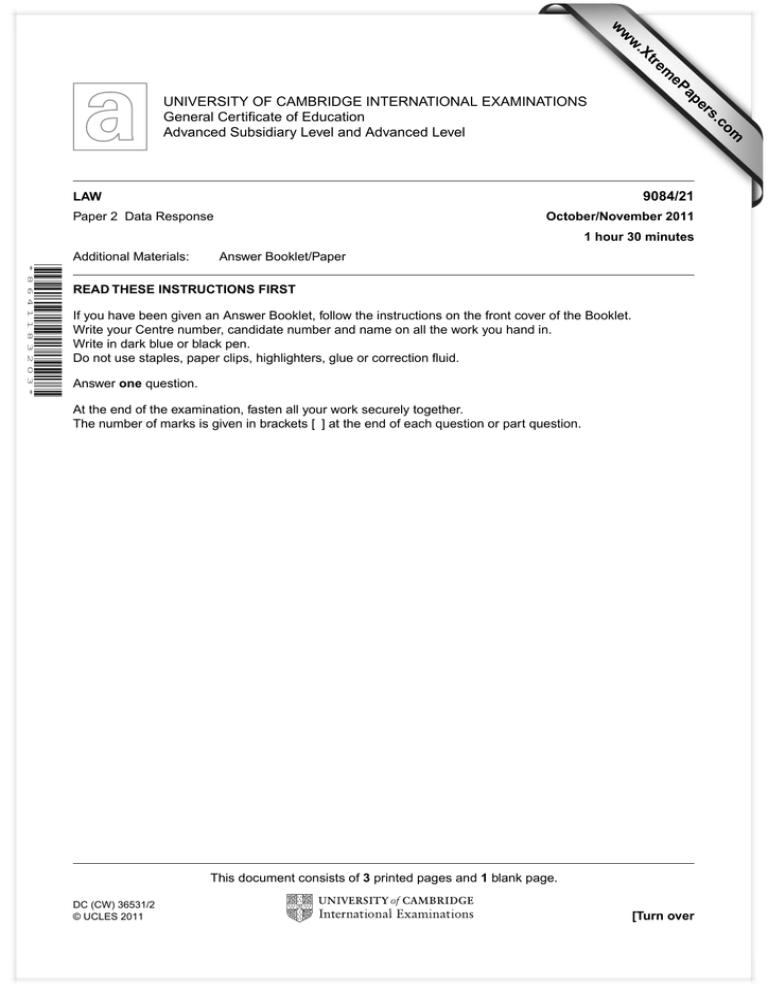
w w ap eP m e tr .X w om .c s er UNIVERSITY OF CAMBRIDGE INTERNATIONAL EXAMINATIONS General Certificate of Education Advanced Subsidiary Level and Advanced Level 9084/21 LAW Paper 2 Data Response October/November 2011 1 hour 30 minutes Additional Materials: Answer Booklet/Paper * 8 6 4 1 1 8 3 2 0 3 * READ THESE INSTRUCTIONS FIRST If you have been given an Answer Booklet, follow the instructions on the front cover of the Booklet. Write your Centre number, candidate number and name on all the work you hand in. Write in dark blue or black pen. Do not use staples, paper clips, highlighters, glue or correction fluid. Answer one question. At the end of the examination, fasten all your work securely together. The number of marks is given in brackets [ ] at the end of each question or part question. This document consists of 3 printed pages and 1 blank page. DC (CW) 36531/2 © UCLES 2011 [Turn over 2 Answer either Question 1 or Question 2. You should make appropriate reference to the source material supplied for each question. 1 Hari lives in a flat in Birmingham. Last year he purchased a new television and he is anxious to watch more sport since he is a keen supporter of cricket and football. He has recently suffered interference with the quality of the picture and sound. He has contacted the suppliers of the television and they say there is nothing they can do as the interference can be blamed on the erection of a large block of offices near to his flat. He wants to sue the developers of the office block for his poor television reception. (a) If Hari brings an action against the developers, consider the chances of success of his claim. [10] (b) Would Hari be successful if, instead of claiming that he is suffering interference with his television reception, he claims that his view over the countryside has been affected by the block of offices? [10] (c) Explain the effect of a previous decision in the Court of Appeal on a similar claim in the High Court. [10] (d) Discuss the advantages of upholding the doctrine of precedent in law. [20] Source material Aldred’s Case (1611) It was held that no homeowner had the right to a view from his property. ‘There is no such right known to law as a right to a prospect or a view.’ Hunter v Canary Wharf [1997] Canary Wharf Tower interfered with television reception. Amongst the [claimants] complaining about this, there were many without a proprietary interest, which means without a right in the land, including spouses and children. The Court of Appeal rejected their claim. Lord Justice Pill in Hunter v Canary Wharf ‘… I accept the importance of television in the lives of many people. However, in my judgement the erection or presence of a building in the line of sight between a television transmitter and other properties is not actionable as an interference with the use and enjoyment of land… The loss of view, which may be of greatest importance to many householders is not actionable and neither is the mere presence of a building in the sight line to the television transmitter.’ © UCLES 2011 9084/21/O/N/11 3 2 (a) Consider whether an offence has been committed in the following three cases using the source material below. (i) The police arrest Kray for attempted robbery. He is caught entering a bank wearing a hood covering his face and carrying a hammer. In the back of his car, which is parked 20 metres away from the bank, they find a loaded shotgun. [10] (ii) The police are called to the Dog and Duck Public House where there has been a fight. Briggs is found with an air rifle stuffed inside his jacket. The police ask him whom the air rifle belongs to and he does not answer. [10] (iii) Brian holds a party for Hallowe’en at his house. The neighbours complain to the police about the noise. An officer goes to the house and finds Brian with a plastic gun in his pocket. [10] (b) Consider the various ways that the Police and Criminal Evidence Act 1984 protects a defendant who is taken to the police station for questioning. [20] Source material Firearms Act 1968 s.18 (1) It is an offence for a person to have with him a firearm or imitation firearm with intent to commit an indictable offence. s.19 A person commits an offence if without [lawful] authority or reasonable excuse he has in possession, or purchases or acquires or manufactures, sells or transfers – (a) a loaded shotgun; (b) an air weapon (whether loaded or not); (c) any other firearm (whether loaded or not) together with ammunition suitable for use in that firearm; or (d) an imitation firearm. s.57 (4) an ‘imitation firearm’ means anything which has the appearance of being a firearm … whether or not it is capable of discharging any shot, bullet or other missile. R v Pawlicki and Swindell [1992] Usually ‘have it with him’ would not include guns which are stored some distance away from the defendants at the time of the robbery. However in this case convictions were upheld on two men where at the time of the robbery their guns were inside a locked car about 40 metres away from the intended site of the robbery. Steyn LJ in Pawlicki and Swindell The judge emphasised here that it was not the distance between the criminal and the guns but how accessible the guns were when they were about to commit a criminal offence. © UCLES 2011 9084/21/O/N/11 4 BLANK PAGE Permission to reproduce items where third-party owned material protected by copyright is included has been sought and cleared where possible. Every reasonable effort has been made by the publisher (UCLES) to trace copyright holders, but if any items requiring clearance have unwittingly been included, the publisher will be pleased to make amends at the earliest possible opportunity. University of Cambridge International Examinations is part of the Cambridge Assessment Group. Cambridge Assessment is the brand name of University of Cambridge Local Examinations Syndicate (UCLES), which is itself a department of the University of Cambridge. © UCLES 2011 9084/21/O/N/11



